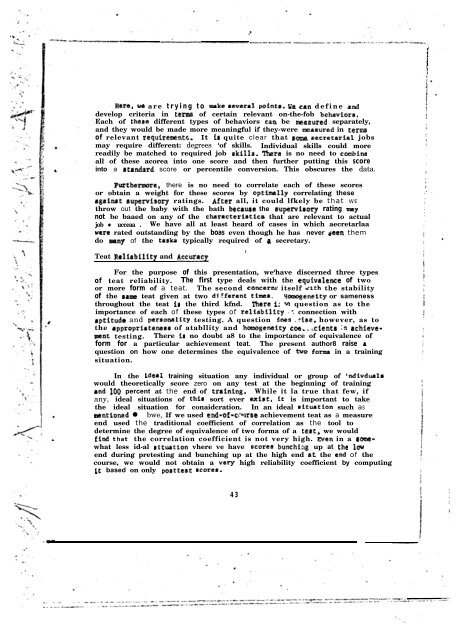Technical Report - International Military Testing Association
Technical Report - International Military Testing Association
Technical Report - International Military Testing Association
Create successful ePaper yourself
Turn your PDF publications into a flip-book with our unique Google optimized e-Paper software.
Here; UC are trying to make acveral pointa. k’s ten define and<br />
develop criteria in term of certain relevant on-the-fob bchsviora,<br />
Each of the&e different types of behaviors coo be rrreaaured separately,<br />
and they would be made more meaningful if they-were aeaeured in terms<br />
of relevant requfrements. It Is quite clear that 8oa.a secretarial jobs<br />
may require different: degrees ‘of skills. Individual skills could more<br />
readily be matched to required job akills. There is no need to coc&ine<br />
all of these acorea into one score and then further putting this score<br />
into a rtandard score or percentile conversion. This obscures the data.<br />
Purthermrc, there is no need to correlate each of these scores<br />
or obtain a weight for these scores by optimlly correlating these<br />
againat auptwisory ratings. After all, it could lfkely be that WE<br />
throw out the baby with the bath because the auperviaory rating may<br />
not be baaed on any of the charecterI8tIca that are relevant to actual<br />
job � ucceaa . We have all at least heard of cases in which aecretarlaa<br />
were rated outstanding by the boas even though he has never deen them<br />
do meny of the taaka typically required of a secretary.<br />
Teat Reliabil1tp and .Accuracx<br />
For the purpose of this presentation, we‘have discerned three types<br />
of teat reliability. The first type deals with the cqufvalence of two<br />
or more form of a teat. The second concerm itself c:Lth the stability<br />
of the seam teat given at two djfferent timor. Youmgenelty or sameness<br />
throughout the teat ir the third kfnd. There 1: w question as to the<br />
importance of each of these types of reliabflfty .Y connection with<br />
aptitude and peraonaiity testing. A question does .clae, however, as to<br />
the appropriatmeaa of atabllity and hamogtneity coe...cienta In achievemant<br />
testing. There ,La no doubt a8 to the importance of equivalence of<br />
form for a particular achievement teat. The present author8 raise a<br />
question on how one determines the equivalence of hro fonaa in a training<br />
situation.<br />
In the ideal training situation any individual or group of ‘ndivduala<br />
would theoretically score zero on any test at the beginning of training<br />
and LOO percent at the end of training. While it la true that few, if<br />
any, ideal situations of this sort ever alat, it is important to take<br />
the ideal situation for conaidcration. In an ideal rituation such as<br />
aamtioned � bwe, If we used end-of-cmrae achievement teat as a measure<br />
end used the traditional coefficient of correlation as the tool to<br />
determine the degree of equivalence of two forma of a teat, we would<br />
find that the correlation coefficient is not very high. E%en in a amwhat<br />
less id-al situation vhere ve have acorta bunchlzg up at the low<br />
end during pretesting and bunching up at the high end at the end of the<br />
course, we would not obtain a very high reliability coefficient by computing<br />
it based on only poatttat acores.<br />
43<br />
I









